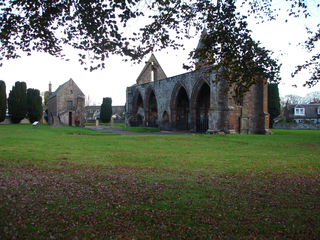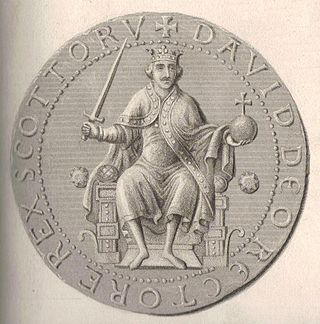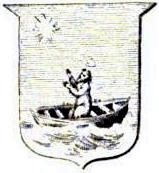Ferchar mac Connaid was king of Dál Riata from about 642 until 650.
Ciniod, Cináed or Cinadhon, son of Uuredech, was king of the Picts from 763 until 775.
Gartnait, son of Domelch, was a king of the Picts from 584 to 595.

The Bishop of St. Andrews was the ecclesiastical head of the Diocese of St Andrews in the Catholic Church and then, from 14 August 1472, as Archbishop of St Andrews, the Archdiocese of St Andrews.
Alan Orr Anderson (1879–1958) was a Scottish historian and compiler. The son of Rev. John Anderson and Ann Masson, he was born in 1879. He was educated at Royal High School, Edinburgh, and the University of Edinburgh.
Fothad II was the bishop of St Andrews (1059–1093) for most of the reign of King Máel Coluim III mac Donnchada. Alternative spellings include Fodhoch, Fothach and Foderoch, and Fothawch. A "Modach filius Malmykel" is mentioned in a grant, dated 1093, as the bishop of S. Andrews. As this bishop is certainly Fothad II, his father was a man named Máel Míchéil.

The Bishop of Ross was the ecclesiastical head of the Diocese of Ross, one of Scotland's 13 medieval bishoprics. The first recorded bishop appears in the late 7th century as a witness to Adomnán of Iona's Cáin Adomnáin. The bishopric was based at the settlement of Rosemarkie until the mid-13th century, afterwards being moved to nearby Fortrose and Fortrose Cathedral. As far as the evidence goes, this bishopric was the oldest of all bishoprics north of the Forth, and was perhaps the only Pictish bishopric until the 9th century. Indeed, the Cáin Adomnáin indicates that in the reign of Bruide mac Der Ilei, king of the Picts, the bishop of Rosemarkie was the only significant figure in Pictland other than the king. The bishopric is located conveniently close to the heartland of Fortriu, being just across the water from Moray.
Fothad I is the second alleged Bishop of the Scots (906x955). We know he had the status of "bishop" during the reign of King Dub mac Maíl Coluim because the Chronicle of the Kings of Alba has his death in the period of his reign (962-967). Such a date is supported by the Irish annals, and according to the Annals of the Four Masters, he died in 963. According to the latter source, he was Fothadh, mac Brain, scribhnidh & espucc Insi Alban; that is, "Fothad, son of Bran, scribe and bishop of the islands of Scotland". This entry taken on its own obviously places some doubt on his status as a bishop of St Andrews. It is only because he is mentioned as a bishop of St. Andrews in the bishop-lists of Walter Bower and Andrew of Wyntoun that he is identified with this see; however no pre-15th century sources actually confirm this, although it is true that there was definitely a bishop of this name in the 11th century. Bower, however, gives some explanation, telling us that Fothad "was driven out by King Indolff; and after his expulsion from the see he lived for 8 years". This Indolff, or King Idulb mac Causantín reigned between 954 and 962. If we take both Bower's statement and the obit reported in the Annals of the Four Masters to be correct, this means that Fothad was expelled in 955. Although it is unlikely anyway, he could not have been bishop before the year 906, when we know his predecessor Cellach was still bishop. That he died in 963 as "espucc Insi Alban" allows the possibility that he transferred his see to Iona or elsewhere on the western coast of Scotland after 955, although this is just conjecture.
Máel Ísu I is the third alleged Bishop of Cennrígmonaid, equivalent to latter day St Andrews. He is mentioned in the bishop-lists of the 15th-century historians Walter Bower (Malisius) and Andrew of Wyntoun (Malice) as the successor of Fothad I, and it is claimed that he reigned as bishop for eight years. If Máel Ísu's predecessor did get expelled from the bishopric in 955,, and if Máel Ísu's reign really was eight years, then Máel Ísu would have held the bishopric between the years 955 and 963.
Cellach II is the fourth alleged Bishop of the Scots, the predecessor of the later St Andrews bishopric.
Máel Dúin is the eighth alleged Bishop of St Andrews. He is mentioned in the bishop-lists of the 15th-century historians Walter Bower and Andrew of Wyntoun as the successor of Bishop Ailín.

Jocelin was a twelfth-century Cistercian monk and cleric who became the fourth Abbot of Melrose before becoming Bishop of Glasgow, Scotland. He was probably born in the 1130s, and in his teenage years became a monk of Melrose Abbey. He rose in the service of Abbot Waltheof, and by the time of the short abbacy of Waltheof's successor Abbot William, Jocelin had become prior. Then in 1170 Jocelin himself became abbot, a position he held for four years. Jocelin was responsible for promoting the cult of the emerging Saint Waltheof, and in this had the support of Enguerrand, Bishop of Glasgow.
Enguerrand was a twelfth-century bishop of Glasgow. He had previously been Archdeacon of Teviotdale, and had served king Máel Coluim IV as Chancellor of Scotland between 1161 and 1164. He was elected Bishop of Glasgow on Sunday, 20 September 1164, and consecrated on 28 October at the hands of Pope Alexander III himself in Sens, France, where the Pope was then resident. He did not return to the diocese until 2 June 1165. Although he resigned the position of Royal Chancellor upon election to the bishopric, there is charter evidence that he once again became Chancellor in the reign of King William the Lion, probably in the year 1171. Notable actions of his episcopate included, probably on the request of his friend Jocelin, then Abbot of Melrose, the opening of the tomb of the emerging saint Walthoef. He died on 2 February 1174.
Marjorie Ogilvie Anderson was a Scottish historian and paleographer.
Clement was a 13th-century Dominican friar who was the first member of the Dominican Order in Britain and Ireland to become a bishop. In 1233, he was selected to lead the ailing diocese of Dunblane in Scotland, and faced a struggle to bring the bishopric of Dunblane to financial viability. This involved many negotiations with the powerful religious institutions and secular authorities which had acquired control of the revenue that would normally have been the entitlement of Clement's bishopric. The negotiations proved difficult, forcing Clement to visit the papal court in Rome. While not achieving all of his aims, Clement succeeded in saving the bishopric from relocation to Inchaffray Abbey. He also regained enough revenue to begin work on the new Dunblane Cathedral.

Historical treatment of David I and the Scottish church usually emphasises King David I of Scotland's pioneering role as the instrument of diocesan reorganisation and Norman penetration, beginning with the bishopric of Glasgow while David was Prince of the Cumbrians, and continuing further north after David acceded to the throne of Scotland. As well as this and his monastic patronage, focus too is usually given to his role as the defender of the Scottish church's independence from claims of overlordship by the Archbishop of York and the Archbishop of Canterbury.
Laurence de Ergadia was a thirteenth-century Scottish bishop. Probably from the MacDougall kindred of Argyll, Laurence had become a Dominican friar and presumably university graduate before being elected Bishop of Argyll, an election which took place sometime between 1262 and 1264. Although the election was quashed by the Pope in 1264, the Pope gave him a fresh provision to the bishopric. Laurence appears intermittently in the records during his three and a half decade episcopate, but his activities in his own diocese are badly recorded. He died as Bishop of Argyll sometime in either 1299 or 1300.

The Diocese of the Isles, also known as the Diocese of Suðreyar, or the Diocese of Sodor, was one of the dioceses of medieval Norway. After the mid-13th-century Treaty of Perth, the diocese was accounted as one of the 13 dioceses of Scotland. The original seat of the bishopric appears to have been at Peel, on St Patrick's Isle, where indeed it continued to be under English overlordship; the Bishopric of the Isles as it was after the split was relocated to the north, firstly to Snizort and then Iona.
John Dongan [Donegan, Donnegan, Donkan, Duncan] was a medieval Manx prelate. After holding the position of Archdeacon of Down, he held three successive bishoprics, Man and the Isles (Sodor), then the see of Derry and lastly, Down.




